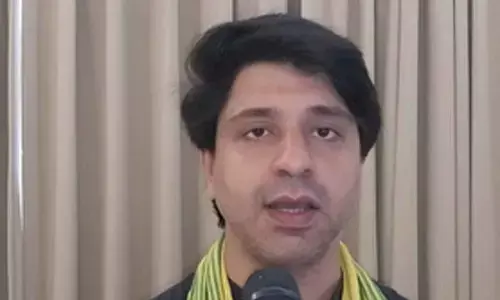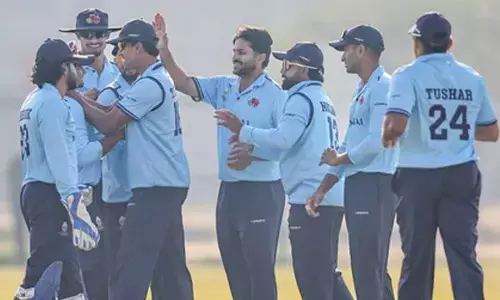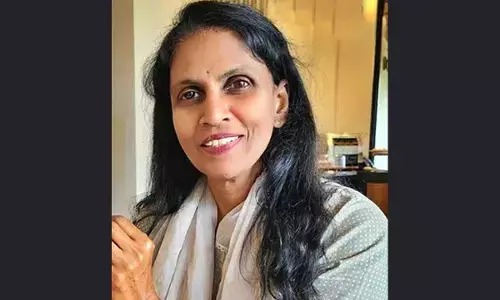Of faith, fervour and tradition

When I was in Class II, we moved to small town, Damala Cheruvu which is about three kilometres away from our village. The most gala celebration of that place during those days was Muharram.
When I was in Class II, we moved to small town, Damala Cheruvu which is about three kilometres away from our village. The most gala celebration of that place during those days was Muharram. There was a small mud-roofed house called Peerla Chavadi near the mosque. A huge bundle covered with green cloth on the attic of that ramshackle house is a common scene as everybody knew that the peers are sleeping in that bundle.
During the Muharram season they would be awakened, and then they would be bathed; placed on the pedestal and worshipped for 13 days. On the second day, a pit would be dug right in front of that house and a bonfire would be made in that pit. Every day the flag of the peers was taken in a procession in the village and every house, irrespective of the caste and the religion offered their prayers to it.
On the final day, all the peers would be taken in a procession and people used to play with colours like Holi. On the night the peer bearers used to walk on the fire followed by many devotees and the entire village was in rapture as they come out of the fire without slightest of burns. I don’t know when that Muharram festival ceased to exist and the peer house was converted into a tailoring shop.
Afsar Mohammad’s book ‘The Festival of Pirs-Popular Islam and Shared Devotion in South India’ reminded me all those things besides giving me the clue to understanding the reasons for the discontinuation of Muharram celebrations in many places. Afsar’s book clearly illustrates the serious way that a research has to be undertaken.
He is on the faculty of University of Pennsylvania and University of Texas and in 2006 he came to India on a scholarship from the American Institute of Indian Studies (AIIS),and spent nine months in Gugudu, a small village about 27 kilometres from Ananthapur, where there is a shrine of Kullai Swamy, another name of the Pir Kullayappa, who was the eldest grandson and heir of the Prophet Muhammad, who was martyred along with his supporters in the battle of Karbala which took place in 680 CE in present day Iraq.
It is a battle that marked the rise of Shi’sm as a distinctive Islamic sect that took the side of ‘Ali, the son-in-law of the Prophet, in a dispute over the legacy of the Prophet. Islam treats Muharram as a public religious event that recreates the Battle of Karbala through various rituals. The Muslim rulers of the medieval times, the Qutb Shahis of Golconda (1518–1687 CE), Hyder Ali (1720–1782 CE), and Tippu Sultan of Mysore (1750–1799 CE) introduced the public rituals of Muharram in Rayalaseema.
The rituals of Muharram have been brought together with Sufi practices which expanded the network of Pir practices resulting in a shared and pluralistic devotional culture. The Muharram festival in this region is a blend of Hindu and Islam customs and rituals. There is an interesting story concocted and then venerated by many devotees in Gugudu which means the nest of Guha and Guha is none other than the boatman who helped Rama, Sita and Lakshmana to reach the other side of the river.
People believe that Rama came to that village after many centuries in the avataram of Peer as Kullayappa meaning the god with a cap. But the local Muslims strongly believe that Kullayappa was one of the Faqirs sent by Baba Fakhruddin to spread the message of Sufism. Muharram is celebrated on a grand scale in Gugudu every year and around 3 lakh pilgrims from the entire South India come there to offer their prayers seeking many wishes as well as to gratify their indebtedness for the fulfilment of their wishes.
The customs and rituals they follow are a curious blend of Hinduism and Islam. It’s something bordering on Sufism. They have firm faith in what Quran proclaims, niyyatu (“pure intention”) and barkatu (“divine blessing”). Adjacent to the peer house, separated only by a wall, there is the temple of Anjaneya who is believed to have saved Guha. Though the main priest of the peer house is a hazrat, many Hindu families in Gugudu have inherited the duties of cleansing and handling the peers which they deem it a prestige not to be forsaken at any cost.
Most of the devotees of Kullayappa belong to Dudekula, a sub-caste of Muslim. Some of the age-old characteristic features of Hinduism seemed to have influenced Gugudu and denigrating a group into a sub-caste is one among them. Discrimination of the women and Dalits in the worshipping also reminds one of the same. But the Dudekula community has imbibed the great quality of simplicity and frugality that Quran preaches.
But many traditional Islam people condemn the worshipping of peers and the ecstatic way that Muharram is celebrated as Islam denounces idolatry and Muharram is a time for mourning. As many Muslims have gradually struck more to the rigid old laws of Islam, peer worshipping in Rayalaseema has gone down considerably and peer houses are deserted and ruined. Muharram is celebrated only in a few places like Gugudu as they believe that those martyrs have the power of rebirth again and again.
Peer worshipping may be a crude version of Sufism but it is a product of the synthesis of the simple and innocent minds of the illiterate people. Whether education and civilisation have been taking the man towards a haven of love and freedom? Afsar Mohammad’s painstaking research work, though detached and truth-seeking, ironically and subtly poses that question once again. - (The writer is a bilingual short story writer, novelist and poet, writing in both Telugu and English)
Woman injured in stabbing attack in Tokyo, suspect at large
Bengal cop booked for murder over mysterious death of woman home guard, SIT to probe case
Staffer recalls horror of 7-kg gold robbery by armed gang in Karnataka’s Hunsur
25-Year-Old Airline Cabin Crew Member Dies At Gurugram Party; Police Begin Investigation
















